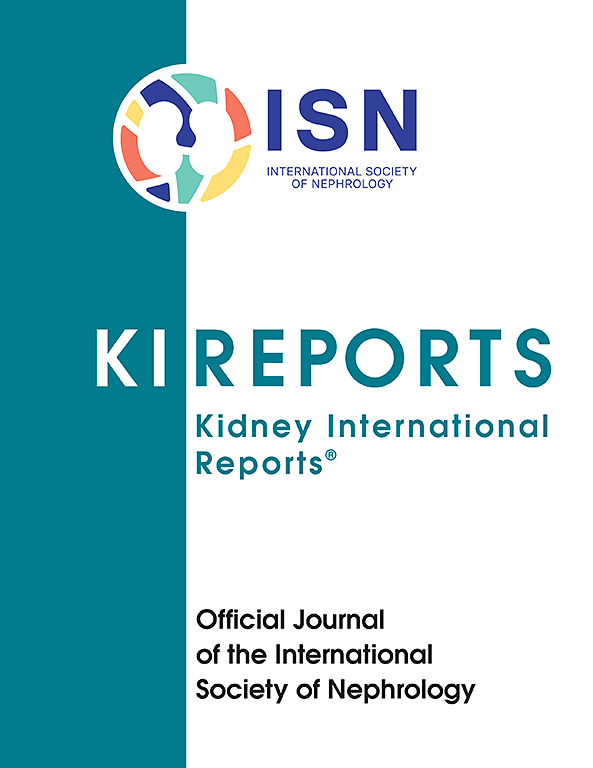Interaction Between Apolipoprotein L1 Genetic Risk and Neighborhood Socioeconomic Status for Kidney Outcomes in a United States Cohort
IF 5.7
2区 医学
Q1 UROLOGY & NEPHROLOGY
引用次数: 0
Abstract
Introduction
Apolipoprotein L1 (APOL1) risk alleles G1 and G2, confer a higher risk of kidney outcomes but are influenced by other genetic and environmental factors. The interaction between neighborhood socioeconomic status (SES) and APOL1 associated risk of kidney outcomes is unknown.
Methods
This retrospective study included self-reported Black individuals with genetic, clinical, and residential data. We defined the neighborhood as a 1 km2 radius circle around their primary residence and used a negative binomial regression model to analyze the interaction between APOL1 variants and neighborhood SES, specifically poverty rate and median household income, for a composite kidney outcome of a sustained 30% estimated glomerular filtration rate (eGFR) decline or end-stage kidney disease (ESKD) over 8 years.
Results
Of 4296 participants, 829 (19%) had the composite kidney outcome; 20% with and 9% without the composite outcome had APOL1 high-risk genotypes. Higher poverty was associated with increased kidney risk (adjusted relative risk [aRR]: 1.08; 95% confidence interval [CI]: 1.01–1.17), whereas higher income was protective (aRR: 0.94; 95% CI: 0.89–0.98). Significant interactions were observed between APOL1 and SES (P < 0.05). Among high-risk APOL1 individuals, higher poverty was linked to lower risk (aRR: 0.86; 95% CI: 0.43–2.75), whereas higher income increased the risk (aRR: 1.07; 95% CI: 0.51–2.13).
Conclusion
Significant interactions between APOL1 genotypes and neighborhood SES on kidney outcomes suggest that APOL1 genetic risk may influence the impact of neighborhood SES on kidney health. Among individuals with APOL1 high-risk variants, a higher neighborhood poverty rate was unexpectedly linked to lower risk, whereas higher neighborhood household income was associated with increased risk.

在一项美国队列研究中,载脂蛋白L1遗传风险与社区社会经济地位对肾脏预后的相互作用
载脂蛋白L1 (APOL1)风险等位基因G1和G2赋予肾脏结局更高的风险,但受其他遗传和环境因素的影响。社区社会经济地位(SES)与APOL1相关的肾脏结局风险之间的相互作用尚不清楚。方法回顾性研究包括黑人个体的遗传、临床和居住资料。我们将社区定义为其主要居住地周围半径1平方公里的圆圈,并使用负二项回归模型分析APOL1变异与社区SES之间的相互作用,特别是贫困率和家庭收入中位数,对于持续30%的肾小球滤过率(eGFR)下降或终末期肾脏疾病(ESKD)超过8年的复合肾脏结局。结果在4296名参与者中,829名(19%)有复合肾脏结局;20%有复合结局,9%无复合结局的患者为APOL1高危基因型。较高的贫困水平与肾脏风险增加相关(调整后的相对风险[aRR]: 1.08;95%可信区间[CI]: 1.01-1.17),而较高的收入具有保护作用(aRR: 0.94;95% ci: 0.89-0.98)。APOL1和SES之间存在显著的相互作用(P <;0.05)。在APOL1高危人群中,贫困程度越高,患病风险越低(aRR: 0.86;95% CI: 0.43-2.75),而较高的收入增加了风险(aRR: 1.07;95% ci: 0.51-2.13)。结论APOL1基因型与社区SES对肾脏预后的显著交互作用表明,APOL1遗传风险可能影响社区SES对肾脏健康的影响。在APOL1高危变异个体中,较高的社区贫困率出乎意料地与较低的风险相关,而较高的社区家庭收入与较高的风险相关。
本文章由计算机程序翻译,如有差异,请以英文原文为准。
求助全文
约1分钟内获得全文
求助全文
来源期刊

Kidney International Reports
Medicine-Nephrology
CiteScore
7.70
自引率
3.30%
发文量
1578
审稿时长
8 weeks
期刊介绍:
Kidney International Reports, an official journal of the International Society of Nephrology, is a peer-reviewed, open access journal devoted to the publication of leading research and developments related to kidney disease. With the primary aim of contributing to improved care of patients with kidney disease, the journal will publish original clinical and select translational articles and educational content related to the pathogenesis, evaluation and management of acute and chronic kidney disease, end stage renal disease (including transplantation), acid-base, fluid and electrolyte disturbances and hypertension. Of particular interest are submissions related to clinical trials, epidemiology, systematic reviews (including meta-analyses) and outcomes research. The journal will also provide a platform for wider dissemination of national and regional guidelines as well as consensus meeting reports.
 求助内容:
求助内容: 应助结果提醒方式:
应助结果提醒方式:


